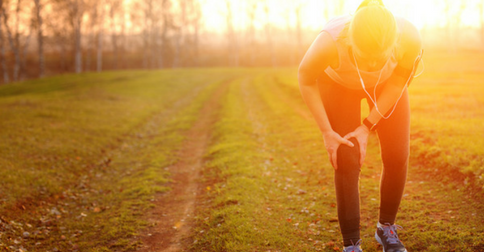
Runner’s knee is a general term used for a number of specific knee conditions, including patellofemoral pain syndrome (PFPS.) This condition can be quite common with the repeated stress of running.1,2
Here is what runners should know about the condition known as runner’s knee as well as how to treat and prevent this type of painful injury.
Causes of Runner’s Knee
The structure of the legs contributes to the development of runner’s knee, and symptoms can arise when the joint is misaligned, like when the patella(knee-cap) no longer glides seamlessly along the femoral groove in the thighbone.3 Feet with high arches, very flat feet, and knees that turn inwards or outwards can also cause the condition.4
Runners may also develop runner’s knee if they have tight hamstrings and calves because when these muscles are tight and paired with weak quadriceps, the knee can become misaligned. Those who run very frequently and long distances are at an increased risk as well.
Symptoms of Runner’s Knee
Individuals who are diagnosed with runner’s knee describe the pain as tenderness around the center of the kneecap.1,5 Pain can also be felt at the back of the knee, and some runners feel like one or both knees is “giving out” when they have this condition. Swelling of the joints or a grinding sensation in the joint may occur as well.
This type of pain originates from the kneecap after the patellar tendon is subjected to repetitive and lengthening loading by the quadriceps. Studies have found that young, female recreational runners are most likely to develop runner’s knee, and running downhill can make the condition worse. Women typically have wider hips, which creates a larger angle from the knee to the thighbone and causes more stress on the kneecap.7
Treatments for Runner’s Knee
Once knee pain strikes, a runner should cut back on the running distance to lessen the load on the knees.1,6,7 It may be time to invest in some new running shoes or supportive orthotics if knee pain persists. JointFlex is a powerful pain relief cream trusted by runners, and its exclusive Fusome® skin delivery technology is designed to deliver the healing ingredients quickly and safely to the skin.
It may help to ice the knee to reduce pain and swelling for 20-30 minutes every few hours on consecutive days. Wrapping the knee in an elastic bandage, elevating it, and taking anti-inflammatories like ibuprofen may help with the symptoms as well.
How to Prevent Runner’s Injuries
Fortunately, there are many ways that athletes can prevent runner’s knee injuries before they strike. It’s important to strengthen the quadriceps with weight training exercises and stretch before and after running to loosen up tight hamstrings.7 Strength training exercises for the hips and core muscles have shown to improve knee function and reduce knee pain as well.
Soft surfaces, like dirt, grass, and rubberized tracks are easier on the knees,8 and running experts recommend limiting mileage increases to 10 percent per week and gradually adding hills to runs.9 Short strides on hills help protect the knee once the injury has healed enough to increase mileage again.
It’s also worth mentioning that not only runners are affected by runner’s knee and that walking, biking, jumping, and other exercises can cause these symptoms as well. That’s why it’s so important to listen to one’s body and consult a trusted medical professional if knee pain does not subside with the treatments and preventative measures highlighted here.
REFERENCES for RUNNER’S KNEE and HOW IT’S TREATED
1. Patellofemoral pain syndrome (Runner’s knee). Johns Hopkins Medicine. Retrieved October 26, 2018 from https://www.hopkinsmedicine.org/healthlibrary/conditions/mens_health/patellofemoral_pain_syndrome_runners_knee_85,P07841.
2. Patellofemoral pain syndrome. American Academy of Orthopaedic Surgeons. Retrieved October 26, 2018 from https://orthoinfo.aaos.org/en/diseases–conditions/patellofemoral-pain-syndrome/.
3. O’Brien, K. B. Runner’s knee. The Nemours Foundation. Retrieved October 26, 2018 from https://kidshealth.org/en/teens/runners-knee.html.
4. Levy, J. (2016 December 29). Pronation problems: Signs, causes & ways to correct these common posture issues. Dr. Axe. Retrieved October 26, 2018 https://draxe.com/pronation/.
5. Khadavi, M. (2016 January 20). What you need to know about runner’s knee. Sports Health. Retrieved October 26, 2018 from https://www.sports-health.com/sports-injuries/knee-injuries/what-you-need-know-about-runners-knee.
6. Khadavi, M. (2016 November 4). Treatment of runner’s knee. Sports Health. Retrieved October 26, 2018 from https://www.sports-health.com/sports-injuries/knee-injuries/treatment-runners-knee.
7. Levy, J. (2016 December 29). Natural treatment for runner’s knee (Hint, surgery is almost always unnecessary). Dr. Axe. Retrieved October 26, 2018 from https://draxe.com/natural-treatment-runners-knee//.
8. Top 10 running surfaces. Runner’s World. Retrieved October 26, 2018 from https://www.runnersworld.co.uk/health/top-10-running-surfaces.
9. Burfoot, A. (2001 November 14). The 10-Percent rule. Runner’s World. Retrieved October 26, 2018 from https://www.runnersworld.com/training/a20781512/the-10-percent-rule/.
